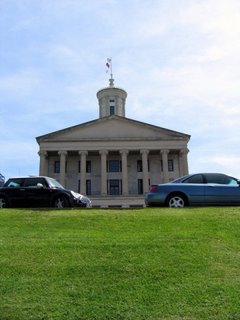
I first came to the site of the first Catholic church in Tennessee.

Then to the grave of President James K. Polk, the 11th President of the United States (1845-1849). The White House site says, "Often referred to as the first "dark horse" President, James K. Polk was the last of the Jacksonians to sit in the White House, and the last strong President until the Civil War."
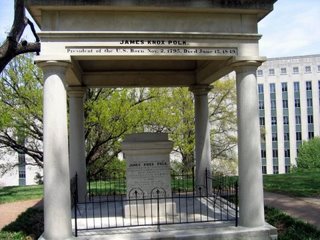
These inscriptions are found on each of the four sides of his tomb:

Wikipedia has this to say about Polk's ownership of slaves: "Polk was a slaveholder for almost his entire adult life. His father Samuel left title to over 8,000 acres of land and about 53 slaves to his widow and his children; James inherited control over nine of his father's slaves, either directly or from deceased brothers. In 1831, he became an absentee cotton planter, sending slaves to clear plantation land that his father had left him near Somerville, Tennessee. Three years later he sold his Sommerville plantation and bought 920 acres of land, together with his brother-in-law, for a cotton plantation near Coffeeville, Mississippi. He ran this plantation for the rest of his life, eventually taking it over completely from his brother-in-law. He infrequently bought more slaves and sold others, although once he became President and could better afford it, he bought more slaves.
"The effect of his ownership of slaves on policymaking has been argued. He believed in the states' right to regulate slavery, as shown by his adamant refusal to endorse the Wilmot Proviso, even though he stated in his diary that he believed slavery could not exist in the territories won from Mexico. He also supported extending the Missouri Compromise line to the Pacific, which would cut off slavery above 36 30' west of Missouri, but mandate it below that line.
"Polk's will stipulated that their slaves were to be manumitted after both he and his wife Sarah had died. The slaves were freed by the Emancipation Proclamation and the Thirteenth Amendment."

Historian Sean Wilentz says in the April 2006 Issue of Rolling Stone, "In the 1840s, President James Polk gained a reputation for deviousness over his alleged manufacturing of the war with Mexico and his supposedly covert pro-slavery views. Abraham Lincoln, then an Illinois congressman, virtually labeled Polk a liar when he called him, from the floor of the House, "a bewildered, confounded and miserably perplexed man" and denounced the war as "from beginning to end, the sheerest deception." But the swift American victory in the war, Polk's decision to stick by his pledge to serve only one term and his sudden death shortly after leaving office spared him the ignominy over slavery that befell his successors in the 1850s."


Next I came across some beautiful spring flowers and decided to take a look close-up.



You can see my fingers holding this one still in the light breeze that was blowing.

Next I came across a Geodesic Survey marker, which looks to me like a tiny Stonehenge. What do you think?

I stooped down for a closer look. I wonder why this marker is here and what it signifies?

and a replica of the Liberty Bell, complete with fake crack.

Next I strolled over to the statue of Andrew Johnson, who was the 17th President of the US (1865-1869). The White House site says, "With the Assassination of Lincoln, the Presidency fell upon an old-fashioned southern Jacksonian Democrat of pronounced states' rights views. Although an honest and honorable man, Andrew Johnson was one of the most unfortunate of Presidents. Arrayed against him were the Radical Republicans in Congress, brilliantly led and ruthless in their tactics. Johnson was no match for them. "

Wikepedia says, "Andrew Johnson was born in Raleigh, North Carolina in 1808, and like the previous North Carolina born presidents, Andrew Jackson and James K. Polk, he was elected to office from Tennessee. Although a native of the South, Johnson was a firm supporter of the Union. During the desperate days of the Civil War, he served as the military governor of Tennessee and finally as vice-president under the second term of Abraham Lincoln. After Lincoln's assassination, the heavy task of restoring a nation after the ravages of a civil war fell to the tailor from North Carolina. The final act leading to the Civil War occurred during Johnson's service in the Senate. Johnson was a Southerner and supported the Fugitive Slave Law and defended slavery. He warned that the dissolution of the Union would produce many minor countries ruled by various forms of government. In spite of Johnson's strong support of the Constitution and the Union, Tennessee seceded from the United States. Johnson rejected the Confederacy and was the only Southern senator to remain in the U.S. Senate after secession. Johnson's support of the Union won acclaim in the North and infamy in the South." He became president after Lincoln's assassination. Wikipedia goes on to say, "Johnson's presidency, though a turbulent one, began the reunification for a country suffering from four years of civil war. It saw the addition of Nebraska to the United States and the purchase of the Alaska territory. He completed the remainder of Abraham Lincoln's term of office but failed to receive his party's nomination in 1869."
So the first two Tennessee presidents represented in statuary weren't born in Tennessee. But we need to remember that in those days most of the state was frontier territory.
Next I happened upon a time capsule, upon which are inscribed the following words: "The articles beneath this triangle were deposited by Nashville Council No. 1 Royal and Select Masters on July 27, 1927 Under Authority of a Joint Resolution adopted by both houses of the sixty-fifth General Assembly of the State of Tennessee. Here to remain one hundred years."

I wonder what "Royal and Select Masters" means? What is in the capsule? Why was it buried?
Does anyone know? I may inquire with the Chamber of Commerce and will post my answer here if I get one.
Then I came to the statue of Andrew Jackson 7th President of the US (1829-1837).
 Wikipedia says, "Nicknamed "Old Hickory," because he was known for his toughness, Jackson was the first President primarily associated with the American frontier (although born in South Carolina, he spent most of his life in Tennessee). Nicknamed "Old Hickory," because he was known for his toughness, Jackson was the first President primarily associated with the American frontier (although born in South Carolina, he spent most of his life in Tennessee). Jackson came to Tennessee by 1787, having barely read law, but finding that enough to become a young lawyer on the frontier. Since he was not from a distinguished family, he had to make his career by his own merits; and soon he began to prosper in the rough-and-tumble world of frontier law. Most of the actions grew out of disputed land-claims, or from assaults and battery. His courtroom demeanor was of his time. In 1795, he fought a duel with an opposing counsel over a courtroom argument. Jackson's service in the War of 1812 was conspicuous for its bravery and success. The war, and particularly his command at the Battle of New Orleans on January 8, 1815, made his national reputation; and he advanced in rank to Major General. In the battle, Jackson's 6,000 militiamen behind barricades of cotton bales opposed 12,000 British regulars marching across an open field, led by General Edward Pakenham. The battle was a total American victory. The British had over 2,000 casualties to Jackson's 13 killed and 58 wounded or missing."
Wikipedia says, "Nicknamed "Old Hickory," because he was known for his toughness, Jackson was the first President primarily associated with the American frontier (although born in South Carolina, he spent most of his life in Tennessee). Nicknamed "Old Hickory," because he was known for his toughness, Jackson was the first President primarily associated with the American frontier (although born in South Carolina, he spent most of his life in Tennessee). Jackson came to Tennessee by 1787, having barely read law, but finding that enough to become a young lawyer on the frontier. Since he was not from a distinguished family, he had to make his career by his own merits; and soon he began to prosper in the rough-and-tumble world of frontier law. Most of the actions grew out of disputed land-claims, or from assaults and battery. His courtroom demeanor was of his time. In 1795, he fought a duel with an opposing counsel over a courtroom argument. Jackson's service in the War of 1812 was conspicuous for its bravery and success. The war, and particularly his command at the Battle of New Orleans on January 8, 1815, made his national reputation; and he advanced in rank to Major General. In the battle, Jackson's 6,000 militiamen behind barricades of cotton bales opposed 12,000 British regulars marching across an open field, led by General Edward Pakenham. The battle was a total American victory. The British had over 2,000 casualties to Jackson's 13 killed and 58 wounded or missing."(Listen to "The Battle of New Orleans" by Johnny Horton. It's worth noting that the war was actually over before the Battle of New Orleans began, but news did not reach New Orleans in time to avert the battle.)
Today, perhaps the most controversial aspect of Andrew Jackson's presidency was his policy regarding American Indians. Jackson was a leading advocate of a policy known as "Indian Removal", signing the Indian Removal Act into law in 1830. The Removal Act was especially popular in the South, where population growth and the discovery of gold on Cherokee land had increased pressure on tribal lands. The state of Georgia became involved in a contentious jurisdictional dispute with the Cherokees, culminating in the 1832 Supreme Court decision (Worcester v. Georgia) that ruled that Georgia could not impose its laws upon Cherokee tribal lands. Jackson used the Georgia crisis to pressure Cherokee leaders to sign a removal treaty. A faction of Cherokees led by Jackson's old ally Major Ridge negotiated the Treaty of New Echota with Jackson's administration, a document of dubious legality which was rejected by most Cherokees. However, the terms of the treaty were strictly enforced by Jackson's successor, Martin Van Buren, which resulted in the deaths of thousands of Cherokees along the "Trail of Tears".
And so we have another president from Tennessee who was involved in tragedy.
Next I walked to the front of the capitol and examined the statue of Edward W. Carmack that glares down onto Charlotte Avenue toward the new Public Library.

This statue has always puzzled me. It commands the front steps of the capitol. You would think they would have placed "Old Hickory" or any of the other Tennessee Presidents there. Why is Carmack scowling down at the city with clenched fists? Does this say something about the lingering effects of the Civil War?
The bronze plaque on the back on Carmack's statue is known as "Carmack's Pledge to the South " and was excerpted from a speech he delivered in the United States House of Representatives. It reads:
"The SOUTH is a land that has known sorrows; it is a land that has broken the ashen crust and moistened it with tears; a land scarred and riven by the plowshare of war and billowed with the graves of her dead; but a land of legend, a land of song, a land of hallowed and heroic memories.
"To that land every drop of my blood, every fiber of my being, every pulsation of my heart, is consecrated forever. I was born of her womb; I was nurtured at her breast; and when my last hour shall come, I pray GOD that I may be pillowed upon her bosom and rocked to sleep within her tender and encircling arms."
 Wikipedia has this to say about Carmack: Edward Ward Carmack (November 5, 1858 – November 8, 1908) was an attorney, newspaperman, and political figure who served as a U.S. Senator from Tennessee from 1901 to 1907. Carmack was born in Sumner County, Tennessee. He attended the Webb School, then at Culleoka, Tennessee. He studied law and was admitted to the bar in 1878 and began practicing in Columbia, Tennessee. He served as Columbia city attorney in 1881, and was elected to the Tennessee House of Representatives in 1884. Carmack was elected to the United States House of Representatives in 1896, and served two terms in that body, March 4, 1897 - March 3, 1901.
Wikipedia has this to say about Carmack: Edward Ward Carmack (November 5, 1858 – November 8, 1908) was an attorney, newspaperman, and political figure who served as a U.S. Senator from Tennessee from 1901 to 1907. Carmack was born in Sumner County, Tennessee. He attended the Webb School, then at Culleoka, Tennessee. He studied law and was admitted to the bar in 1878 and began practicing in Columbia, Tennessee. He served as Columbia city attorney in 1881, and was elected to the Tennessee House of Representatives in 1884. Carmack was elected to the United States House of Representatives in 1896, and served two terms in that body, March 4, 1897 - March 3, 1901.He was then elected by the US Senate, serving one term in that body, March 4, 1901 - March 3, 1907. He failed to secure reelection to a second Senate term, being succeeded by former governor of Tennessee Robert L. Taylor, and returned to the practice of law. He then contended for the 1908 Democratic nomination for governor; when this proved to be unsuccessful as well, he then returned to editing the Nashville American. On November 8, 1908, he was shot down on the streets of Nashville over something he had said in the paper which had prompted a feud. Perhaps in large measure because of the spectacular and violent nature of his death, a large bronze statue of him was erected on the grounds of the Tennessee State Capitol building in which he seems to be gesturing to the plaza across the street. His remains were returned to Columbia, and he was buried in Rose Hill Cemetery there.
I still no clue why an angry newspaperman glares down at the city. Yet another enigma for me to ponder.
I then stepped in front of Carmack to get a look at the Legislative Plaza and the new public library in the distance.
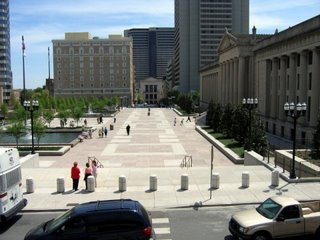
Next I climbed the steps to get a look from the top. You can see Carmack in the middle of the picture.

Next I walked around to the side of the capitol, from which can be seen the Tennessee State Supreme Court

and the State Archives.
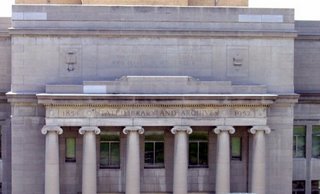
Next I wandered around to the back to get a different perspective on the capitol.

There I found this delightful little bell tower (I suppose that's what it is)

with these plaques memorializing various types of music for which Tennessee is known.
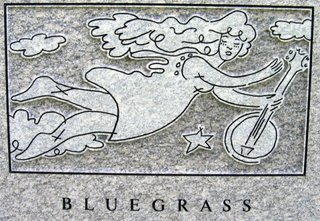
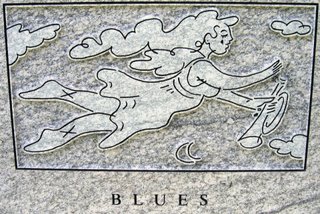

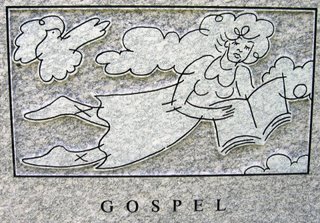


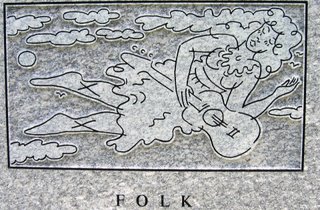
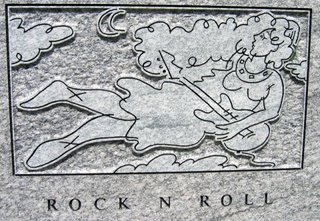

1 comment:
Nashville has a lot of history to it, plus all that musical appeal. Whenever we have visitors from afar, they want to go to Nashville.
Post a Comment